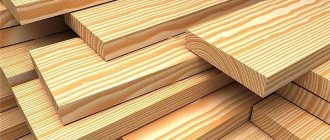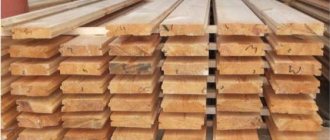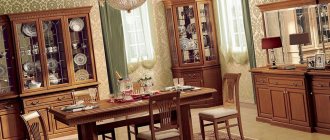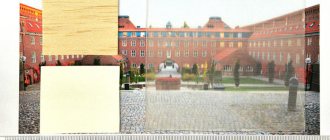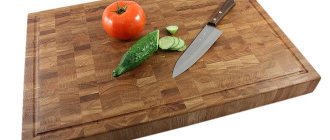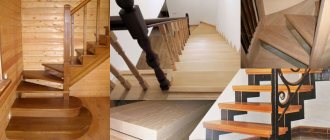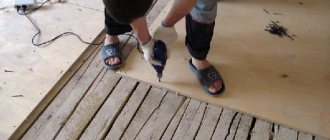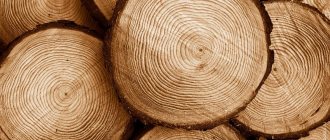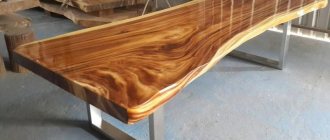General overview of wood
It was not for nothing that the famous poet A.S. Pushkin called the oak “the patriarch of our forests”; this is a venerable tree throughout Russia. Wooden products made from oak are widely used in the construction industry, for example, when creating exclusive and luxury interiors. If we talk about the carpentry industry, then among the many hardwoods, preference is given to oak wood. It is distinguished by such qualities as elasticity, flexibility, and increased hardness. Wood is best suited for the production of furniture and household items. It is used to build high-quality and durable buildings and structures, bridges, and other engineering structures.
The wood of the so-called summer tree is highly valued, especially that which is located closer to the core - sound wood. It has an outer ring and inner layers that do not participate in the necessary life processes of the tree. Because of this feature, self-preservation or its gradual petrification occurs. Such properties determine the strength of the building material, thanks to which it is not susceptible to such defects as cracking and warping. The disadvantage of such wood is its vulnerability to splitting along radial stripes directed from the core.
Basic properties
The material is resistant to the effects of biological organisms; mold and mildew do not grow on it. Oak is not damaged by various insects. The strongest part of the wood is the one closest to the root system.
It is worth noting natural possible defects. Thus, material from trees grown in temperate climates may develop cracks in the presence of severe frosts. Carpentry practice shows that specimens growing in the foothills of the Caucasus, in the Krasnodar Territory, are characterized by positive strength properties. This type of wood most often has light brown shades.
Where is wood used?
Hardness and high service life allow the wood to be used in shipbuilding and the mining industry. It has a high density, which is important for construction and finishing work.
Wood is used to create furniture, toys, and parquet. It can be tinted to give it a new shade. But it has its own rich palette, found in both light beige and dark brown shades.
The beneficial composition of the fruits has made them one of the ingredients for the preparation of medicines.
Material characteristics
There are no analogues to oak wood in carpentry. The average tree lives about 600 years, and some specimens live 1000 years or more. In Europe alone there are about 20 species of this representative of the flora. Due to the characteristics of the place of growth, the resulting wood changes its operational and physical characteristics, but general characteristics also stand out:
• resistance to deformation; • density; • hardness of radial and tangential type; • cutting resistance.
Varieties
The properties of wood vary depending on the area where the trees grow.
It is customary to distinguish the following types:
- Hog, holm or oak oak grows preferably in sandy and dry areas. It is characterized by an almost black and thickened bark, the wood is straw-yellow in color with a fine-grained structure, exhibits increased hardness, but little elasticity.
- Lead or water oak, iron oak most often grows on the coasts bordering fast-flowing bodies of water. Distinctive features are a bluish-gray tint, a straight trunk is occasionally covered with whitish spots, and the top is dense. It is also found in alder bogs, which is where its other name comes from - “olsovy”. It produces wood that has a pale pink tint; sapwood is white. The material is quite elastic and heavy, but may crack during drying.
- In the area between the ols and the pine forest, oak is found, from which wood is obtained that has transitional characteristics. Its shade is yellowish, there is white sapwood. Increased elasticity is noted in comparison with oak wood, but inferior to its analogue. The hardness indicator is inferior to the two previous types. The trunk has soft and thick gray-brown bark. A reddish coating is visible in the cracks, and greenish moss always grows on the northern part. There is often a hollowness in the butt part of the trunk.
- The wood described is an excellent ornamental and building material. Summer oak is used to make durable and reliable buildings of land and underwater types; various parts are built on wooden ships; in general, it is used in maritime affairs. Winter wood is used in mechanical engineering, cooperage and construction.
- Special attention should be paid to stained wood, which is kept in water for many years. It is distinguished by a dark, almost black color, and is easily subjected to artificial aging. When burned, oak gives off a significant amount of heat, but this process requires constant air draft. The resulting charcoal does not hold heat very well.
- The Crimean region and the Caucasus are optimal areas for growing cork oak.
Recommended species and varieties
Q. borealis
The crown is spherical. Leaves fall only in the harshest winters. Their plates are obovate, with rounded lobes, 12.5 cm long. The bark cracks with age and becomes brownish-gray. A heat-loving species that in Russia can be cultivated in the south of the Krasnodar Territory. The height and diameter of the plant is 8x5 m (20 years). Maximum height - 30 m.
Heat-loving species
Q. castaneifolia "Greenspire"
The crown is narrow. The leaves that fall in winter are glossy, oblong or oval, with rough triangular teeth along the edge, about 18 cm long. The height and diameter of the plant is 14x5 m (20 years). Maximum height - 30 m.
Leaves are glossy
Q. coccinea
The dark green leaves turn scarlet in the fall and fall off. Their plate is 15 cm long, with pointed lobes. The silvery-gray-brown bark remains smooth for many years. Homeland - eastern USA and South-East. Canada. In Europe, acorns are rarely produced. Resistant down to -30°C. The height and diameter of the plant is 10x8 m (20 years). Maximum height - 25 m.
Dark green leaves
"Splendens"
The autumn color of the leaves of this variety is especially attractive.
"Splendens"
Q.frainetto (D. hungarian)
The leaves are deciduous, leathery, multi-lobed, up to 18 cm long. Their blades are narrow at the base and widest at the apex. Homeland - E. Europe. Withstands down to -20°C, and is therefore recommended for the southern regions of Russia. The height and diameter of the plant is 8x5 m (20 years). Maximum height is 30 m.
Leaves falling, leathery
Q. ilex (D. stone)
An evergreen tree with a spherical crown and dark gray crackling bark. The leaves are up to 6 cm long, leathery, glossy, dark green above and gray below, sometimes with sparse sharp teeth. After a particularly hot summer, small and green, but viable acorns are formed. Despite its relative cold resistance, this oak feels best in a mild coastal climate. Homeland - Chile. This heat-loving subtropical species can only be grown on the Black Sea coast. The height and diameter of the plant is 6x5 m (20 years). Maximum height - 25 m.
Evergreen tree with a spherical crown
Processing principles and application
Carpentry involves the use of hardwood in most cases. Oak takes a leading position in this regard. In addition to its positive physical qualities, there is also a wide range of shades of the material, a beautiful and unusual fiber structure. Oak wood in its finished form bends well and is not susceptible to rotting or exposure to biological pests. The wood has a porous texture, high viscosity, and is easy to process. But in the manufacture of any items, difficulties may arise due to all sorts of defects: knots and large knots.
A radial section demonstrates the large medullary deviations, while a longitudinal section sets a unique natural pattern. Stained wood acquires a rich purple color, and the specific shade depends on the period of such treatment, which also affects the strength indicators. The hardness of the material increases, and a quality such as its fragility appears; the wood splits easily. Extreme care must be taken when working with bog oak wood. It contains a large amount of tanning components, which is why it is easily pickled. The disadvantage is the poor perception of alcohol-based varnishes.
Oak board
Before creating any product, oak wood undergoes a mandatory drying procedure. The oak board is represented by a thin beam. Such timber is well dried before carpentry work is carried out.
In the root zone of the trunk, wood is characterized by increased moisture ingress - about 60%. After cutting the trunk, this figure drops to 20%. If drying is carried out in violation of the technology, a deformation process occurs and the material becomes covered with cracks.
In some areas of daily activity, oak boards with a moisture content of no more than 10% are used. This result is achieved only by aging the wood in special drying chambers. This processing process requires a certain amount of time and is carried out under the strict supervision of specialists. A properly dried board does not contain any obvious visible or hidden defects, its surface is smooth along its entire length.
It is customary to distinguish two types of boards: unedged and edged. In the first case, a flat surface is specified only in the upper and lower planes. The edged material is characterized by the processing of four sides, all its surfaces are geometrically smooth, and it is shaped in the form of a parallelepiped. It is in such wood that the best qualities of oak are preserved as much as possible. It is used in the finishing of ceiling areas, walls, and the production of interior items and furniture.
Oak - the king of the Russian forest
January 12, 2021 One human generation is not always enough to grow an oak tree. Only at the age of 25 does he produce his first acorns. Many of them are long-livers, witnesses of human history.
The popular version of the origin of its name is interesting: in severe frosts, the tree trunk sometimes cracks, accompanying the process with a loud sound - people believed that this tree “stomps” with its only “foot.” The name of this giant supposedly came from the word top.
Oak (lat. Quеrcus) is a genus of tree species of the Beech family. It includes about 600 species, 20 of which grow in Russia. Many of them are found in Europe and northern Africa. A larger number of species form the mountain and lowland forests of both Americas, eastern and southern Asia. There are no native oaks at all in central Eurasia.
What does oak look like?
An oak is a tree, less often a shrub and, what is most unusual for us, even a shrub with alternate, evergreen leaves or leaves that fall off in the winter. On the plains, trees are taller than in the mountains, growing on average up to 25-30 m. Rare centuries-old individuals at an advanced age of 700 years or more reach a size of 55 m.
The oldest oak in Europe grows in Lithuania - the Stelmuz oak, which is approximately 2 thousand years old.
Shrubs usually cover the soil with a layer of half a meter, for example in Spain, less often they rise from 1 to 2 m in height, but no more. Due to excessive grazing by livestock and intensive logging, many trees do not rise higher than bushes.
Usually oaks have a powerful taproot system , going down to a depth of 5 m. But if the soil has dense underlying rocks - limestone, clay; When overmoistened or on podzols, they form anchor (surface) roots. In tropical forests they develop supporting disc-shaped roots.
An important feature when determining the species is the characteristics of the oak bark. In some plants it is smooth, bearing only lentils. More often it is covered with cracks of varying depths or split into rectangular strips, reminiscent of the surface of clay in the dry season.
The shape of the leaves can be not only the way we are used to seeing it. They are oblong and round. The average length of oak leaf blades is 70-150 mm; in evergreen species they are smaller. Large-leaved and serrated oaks have giant leaves - up to 400 mm in length. The leaf petioles are short, less often long – up to 70 mm; there are also species with almost reduced petioles.
Oak is a monoecious tree and has unisexual flowers. They are inconspicuous, white, small, and appear at the same time as the leaves. Male (staminate) flowers are collected in drooping inflorescences of catkins. Pistillate - solitary or arranged in groups of 2-3 on elongated peduncles. The fruits develop within 1-2 years. Different species of the genus interbreed easily and leave fertile hybrid forms.
Oak fruits are single-seeded acorns, with a remnant of underdeveloped seeds in the upper or lower part. The acorn peel is thin, bare or thick inside, three-layered and pubescent on the reverse side. The plus is most often a cup-shaped organ surrounding the seed, but it also comes in other shapes. It is formed from an overgrown receptacle. Sometimes it extends over more than half the length of the acorn. The outside of the plush is covered with scales.
English oak, or common oak (lat. Quercus robur)
The crown of the oak is spreading and wide, it grows up to 25-40 m. Old oaks of this species have thick, powerful trunks, their bark has pronounced grooves. The leaves are oblong along the edge, large-lobed, dark green.
It blooms simultaneously with the appearance of leaves, in May-June. After male flowers bloom, their pollen remains viable for 5 days. Acorns are surrounded at the base by a cup-shaped plus. Oak lives in mixed and deciduous forests and along the banks of reservoirs.
Cork oak (lat. Quercus suber)
The tree grows up to 20 m, its branches begin to grow close to the base of the trunk. It is distinguished by tomentose-pubescent yellow-gray young branches.
Its bark contains a corky layer. The leaves of cork oak are leathery, evergreen, petiolate, oval in shape, 30-70 mm long. The leaf blades are entire or finely toothed, glossy green above, gray-hairy below. Acorns mature in the first year after fertilization. They are oval, up to 30 mm long, surrounded by a pubescent plus, and taste similar to chestnuts.
The natural habitat of the cork oak is the Western Mediterranean, in Russia it is grown in the Crimea.
Chestnut oak (lat. Quercus castaneifolia)
The life form is a tree, up to 25 m high. The bark of this oak species is gray, the young shoots are pubescent. The leaves are wedge-shaped at the base, heart-shaped, rounded or oval, up to 180 mm long. Their terminal blade is pointed and equipped with sharp teeth. Forms forests in the mountains and plains. Chestnut oak wood is used to make wine barrels and various buildings.
Oak growth conditions
A young oak tree grows with difficulty; it is afraid of direct sunlight, frost, heat, strong shading and wind. It can survive only with sufficient heat and slight lateral shading. It cannot grow in the grass, it is too dark for it, and in open areas it is hot during the day and cold at night. It grows well in young pines and bushes.
In the first years of its life, the tree grows slowly, rising only 10-15 cm per year. But its root quickly forms and branches, deepening by a meter per year. A young oak tree begins to intensively stretch upward only after 10 years of preparation. During one summer, it grows by 0.3-0.4 m. Having lived 500 years, it stretches up to 15 m. Now it does not need protection. He himself becomes the protector of rowan trees and birches.
Economic importance of oak
The Romans called him quercus, which translated into Russian means “handsome.” They decorate city parks and the outskirts of villages. The current name of the plant comes either from the Greek demo - building, or from the Anglo-Saxon timbrer - wooden structure, scaffolding. Indeed, oaks for the most part are important forest-forming species that provide valuable wood to humans.
- Oak wood is widely used in the construction of aircraft, ships, buildings, and in carpentry. In red oaks it is characterized by greater softness and has a beautiful pinkish or red tint.
- Oak wood burns well and produces a lot of heat. It is used to kindle fireplaces and prepare coals for barbecues.
- Oak leaves, bark, leaf galls and pluses contain a lot of tannins. People adapted them for tanning leather.
- The bark of cork and shifting oaks is the main source of cork for industry.
- Acorns are used as a coffee substitute and for feeding pigs. In some species of oak they are sweet and, when fresh, are edible for humans. Five thousand years ago, bread was made from ground oak acorns.
- In China, oak leaves mixed with clay are used to feed mulberry caterpillars.
It is worth adding that sawn oak has a pleasant smell, well known to cognac lovers.
Oak produces phytoncides that kill microbes in 6 minutes. In this they are second only to similar substances from bird cherry. Phytoncides also affect other plants. If an oak grows next to a hazel tree, then it’s bad for both: the biologically active substances of one inhibit the growth of the other. There are no blueberries in oak forests, because oak phytoncides have a bad effect on them. But they do not affect other plants, because oak always has many companions.
Solid oak board and its features
If a classic theater begins with a coat rack, then a good apartment begins with a wooden parquet floor. Fortunately or unfortunately, man does not yet know how to create materials better than nature does. After the era of total linoleum, the fashion for everything natural has returned to us. That is why solid boards made of noble European oak are so valued as flooring.
In the minds of Europeans and especially Russians, the tall and mighty oak is the king and lord of all trees. Our ancestors preferred solid oak boards to all other types of flooring. In terms of beauty, durability and reliability, this tree has no equal in the northern latitudes! Oak products have an expressive texture, hardness and strength. Oak is not afraid of moisture and is extremely resistant to putrefactive processes, this frequent scourge of other types of wood.
History of oak boards
Modern solid wood has its origins in ordinary log halves, which were once laid directly on the earthen floor of a home. With the gradual improvement of construction technology, the first roughly planed boards appeared. They were laid without connecting elements, so due to temperature fluctuations, huge gaps often formed in the flooring. Much later, the boards began to be connected with grooves and ridges and laid on transverse beams.
Nowadays, natural oak parquet is the dream of any housewife. And she dreams of the name massive board Oak in her sweetest dreams! After all, such flooring is, as they say, not only the latest fashion, but also quality for many years to come. Go to any old house or estate, and you will understand that our smart ancestors understood a lot about life. An oak plank floor looks stylish and noble, even after hundreds of years!
How to make a solid oak board
The popularity of solid oak boards, not least of all, ensured the ease of processing oak itself. For all its strength qualities, this tree lends itself perfectly to the tools of a carpenter or joiner. In the skillful hands of a master, massive oak boards are transformed into perfectly smooth flooring without the slightest trace of cracks or gaps.
The modern process of making solid boards is a subtle and delicate science. For this purpose, selected varieties of European oak are selected. The color of this tree is uniform and stable along its entire length. The finished board is surrounded on four sides and at specified angles by grooves-ridges.
At the last stage, a solid Oak board (this is what the finished product is called) is coated with oil or varnish and then processed under ultraviolet light. If the board is laid correctly, in compliance with modern construction standards, such a floor is not afraid of any temperature disasters.
And the consumer is left with only the sweet agony of choice. Listen to the music of the names: Bleached Oak, Old Castle Oak, Red Select Oak, Cognac Oak, Mocha Oak... Connoisseurs of noble antiquity and modern comfort have a place to roam. And now everything will depend only on the size of your personal budget and your imagination!
Development of underground organs
Oak is a dicotyledonous plant and has a taproot. A tree densely covered with foliage needs a lot of moisture and nutrients. Oak groves are demanding of soil fertility; they need loose substrates rich in humus and mineral elements. The oak root system can reach a length of 10 m with a crown diameter of 25 m. Thanks to powerful underground organs, trees grow very stable, able to withstand heavy rains and squally winds.
A natural element that can cause significant damage to oak forests is icing. Under the weight of tens of kilograms of frozen water, oak branches bend to the ground and break. The tree dies because it loses a significant part of its crown and becomes easy prey for insect pests and other phytoparasites. At low air temperatures, young branches and undergrowth of oak seedlings are damaged.


